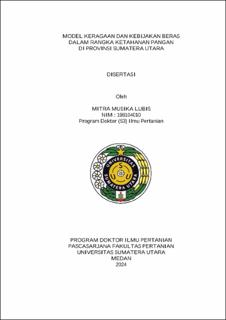Model Keragaan dan Kebijakan Beras dalam Rangka Ketahanan Pangan di Provinsi Sumatera Utara
Rice Performance and Policy Model in Food Security in North Sumatra Province

Date
2024Author
Lubis, Mitra Musika
Advisor(s)
Bakti, Darma
Rahmanta
Ayu, Sri Fajar
Metadata
Show full item recordAbstract
The large land area and rice productivity in North Sumatra Province, as well as its potential, can help increase rice availability. On the other hand, North Sumatra Province still receives rice import distribution from the government to meet its rice availability. Management of rice availability must be carried out efficiently. If the North Sumatra Provincial government fails to meet its rice availability, it could result in an imbalance in rice prices. Because of this mismatch, rice farmers' income is not optimal, and production is also minimal. This will reduce the availability of rice indirectly. The development of rice prices is also an important factor in food security, especially in the rice commodity. The problem of limited access to rice food will also make it more difficult to offer high quality and nutritious food needs and will pose a threat to the long-term viability of food security.
The main aim of conducting this research is to build a simultaneous model, namely a rice performance and policy model in the context of food security in North Sumatra so that, from the results of the study, several important policy alternatives that need to be implemented by the government will be found. The analytical model used is to build a system of simultaneous equations consisting of 11 structural equations and 8 identity equations using the two-stage least squares (2-SLS) estimation method. Evaluation of internal and external factors in the 2000-2022 period was carried out by historical simulation, while variable analysis of government policy during the future period 2023-2027 was used by forecasting simulation.
Changes in government policy by increasing the intervention value of the retail price of rice in the domestic market by 15%, increasing the Highest Retail Price (HET) for fertilizer by 10%, government policy in dealing with rising inflation by 0.5%, increasing the amount of rice imports by 15% and increasing 1% Bulog's real interest rate has caused North Sumatra rice production to increase from year to year with a growth rate of 6.40 percent. The increase in rice production is a result of the increase in rice harvest area which occurs from year to year with an average growth rate of 7.41 percent per year and an increase in rice productivity with a growth rate of 2.90 percent per year. This increase in domestic rice production will result in increased rice availability with a growth rate of 4.10 percent per year followed by growth in the retail price of rice in North Sumatra of 5.74%.
The policy implications for food security, especially rice in North Sumatra Province, should be for the government to combine a policy of expanding rice planting areas with a stimulus to increase the retail price of rice in the domestic market. This must also be followed by providing subsidies for production facilities. Apart from that, this policy can also reduce the amount of rice imports. for North Sumatra. Based on this, the current policy conditions and based on forecasts of endogenous variables, rice self-sufficiency will be achieved in 2027.
